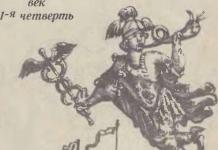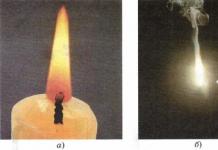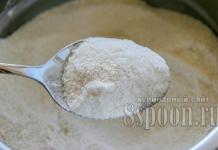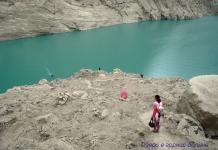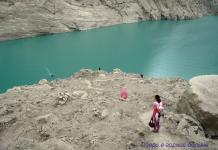КГУ «Тайыншинский колледж агробизнеса»
Учебное пособие по английскому языку для студентов специальности «Фермерское хозяйство»
Разработан преподавателем английского языка
Садыковой Гульнарой Кабдылкадыровной
Учебное пособие по английскому языку для студентов по специальности «Фермерское хозяйство» включает введение, тексты по темам, приложение – словарь, литературу.
Данное учебное пособие имеет практическую значимость. Целью его составления является формирование языковой компетенции студентов ТиПО, для успешного общения на иностранном языке в рамках профессиональной направленности.
Материалы данного пособия помогают формировать навыки ознакомительного чтения на основе словесных опор и фоновых знаний извлекать из текста необходимую информацию
Учебное пособие может выполнять функции руководства по изучению предложенной дисциплины, как на занятиях, так и для самостоятельной работы студентов.
Введение………………………………………………………………………. 4
Tекст 1. Что такое сельское хозяйство? What is agriculture?………………. 5
Текст 2. Две отрасли сельского хозяйства. Two branches of agriculture…… 6
Teкст 3. Мы идём на ферму. We go to the state farm ……………………….. 7
Teкст 4. Преимущества механизации фермы.
Advantages of farm mechanization …………………………………………… 8
Teкст5.Недостатки механизации фермы.
Disadvantages of farm mechanization ………………………………………. .9
Teкст 6. Результаты механизации сельского хозяйства Америки. Effects
of mechanization on American agriculture ……………...…………………….. 10
Teкст7. Советские трактора. Soviet tractors……………………………….... 11
Текст 8. Сельскохозяйственные машины. Farm machines…………………….... 12
Текст 9. Оборудование для жатвы. Harvesting Machinery……………………… 13
Текст 10. Некоторые сельхозмашины в США. Some farm machines in the USA. 14
Текст 11. История плуга. History of the plow……………………………………. 15
Текст 12. Механизация в добычи зерновых. Mechanization in crop production… 16
Текст 13. Значение машин и энергии в сельском хозяйстве. Importance of machinery and energy in agriculture……………………………………………….. 17
Словарь. Vocabulary ………………………….……………………..…..…..……. 19
Литература………………………………………………………………………... 22
Введение
Цель пособия – заложить основы навыков чтения и перевода текстов средней трудности. Работая по данному пособию, у студентов формируются практические навыки различных видов речевой деятельности.
Структура пособия. Пособие состоит из текстов, контрольно - тренировочных упражнений и словаря в качестве приложения.
Основной текст урока направлен на развитие навыков чтения вслух, умения извлекать полную и частичную информацию, основную идею. Текст также является основой для монологической и диалогической речи.
Далее следуют упражнения, имеющие целью проверку понимания и осмысления содержания текста, активизацию мыслительной деятельности учащихся. Предварительно, однако, преподавателю следует объяснить учащимся сложные места текста, оказавшиеся для них непонятными.
Система упражнений направлена на обучение чтению различных видов (изучающего, ознакомительного, просмотрового и поискового). В пояснениях к тексту раскрывается значение тех или иных реалий, фразеологизмов, сокращений и т.п. За пояснениями к тексту следует подлежащий заучиванию лексический минимум, который содержит до 20 наиболее употребительных в сельскохозяйственных текстах общенаучных слов и терминов. Остальные слова, необходимые для понимания текста, студенты отыскивают в словаре и записывают в тетради.
В конце пособия имеется англо-русский словарь терминов, встречающихся в текстах, но отсутствующих в рекомендуемых студентам общих словарях.
Read and translate the text:
Text 1. What is agriculture ?
Agriculture is an important branch of economy. Economic growth of any country depends on the development of agriculture which supplies people with food and clothing and industry with raw materials.
The word "agre" is a Latin word. It means the cultivation of fields in order to grow crops. Now agriculture also includes the use of land to breed
We do not know when people began to grow crops. It was many thousand years ago. Now crop production and animal husbandry are highly developed branches of agriculture.
Life is impossible without plants. They play a highly, important role in everyday life of people. Plants that ate grown by farmers are known as farm crops. They are used for many different purposes. Most of them are used directly as food for people, some are consumed by farm animals, others are used in industry and medicine.
In order to increase crop yields and animal products our collective and state farms apply widely intensive technologies.
Learn the words.
agriculture – сельское хозяйство
animal – животные
apply - применять
breed – разводить
crop - культура
cultivation – обработка
develop – развивать
development – развитие
farm – ферма, хозяйство
field – поле
food – пища
grow – расти, выращивать
growth –рост
increase – увеличение
plant – растение
supply – снабжать
use – использовать
yield – урожай
Call equivalents following international words: region, climate, machine, tractor, combine, bulldozer, to mechanize, tendency, tradition, traditional, industrial.
2. What questions are answered in the text:
Из каких отраслей состоит сельское хозяйство?
Когда люди начали выращивать сельскохозяйственные культуры?
Может ли человек жить, не выращивая культуры?
О каких интенсивных технологиях говорится в тексте?
3. Answer the following questions :
1. Why is agriculture very important?
2. What are the two branches of agriculture?
3. What does the Latin word "agre" mean?
4. Is life possible without plants?
5. Where are farm crops used?
6. How do people increase crop yields?
Read and translate the text:
Text 2. Two branches of agriculture
There are two main branches of agricultural production - crop production and animal husbandry.
Crop production is the practice of growing and harvesting crops. The most important crops grown by man are grain crops, vegetables and grasses. In order to obtain high yields crops are grown under favorable soil and climatic conditions.
Animal husbandry is a branch of agriculture including the breeding of
farm animals and their use. Dairy and beef cattle, hogs, sheep, and poultry
are widely bred throughout the world. Farm animals are highly important
sources of food for man. They are kept for the production of such nutritious
products as meat, milk and eggs.
Many crops grown by man are used in feeding livestock. At the same time manure produced by farm animals is an important source for the maintenance of soil fertility . Most of the nutrients taken by plants from the soil are thus returned. Applying manure, farmers improve the physical condition of the soil.
Thus, crop production and animal husbandry are closely connected with each other.
Explanations to the text:
Under… conditions – при (в) … условиях
With each other – друг с другом
Notes:
Some – несколько, некоторый
The same – тот же самый, один и тот же
Learn the words.
beef cattle - мясной скот
dairy cattle – молочный скот
favourable - благоприятный
grain - зерно
grass - трава
hog - свинья
improve - улучшать
manure - навоз
milk - молоко
nutrient – питательное вещество
poultry – домашняя птица
to produce - производить
sheep – овца, овцы
soil fertility – плодородие почвы
1. Answer the following questions :
1. What are the two branches of agriculture?
2. What is crop production?
3. What are the main farm crops?
4. What does animal husbandry include?
5. What products do farm animals produce?
6. What is manure used for?
7. How do farmers improve the physical condition of the
2. Translate the sentences (pay attention to the words some and same ): 1. Some farmers keep poultry in poultry houses in summer and in winter.
2. All grain crops take the same nutrients from the soil.
3. Some cultural practices are highly effective in controlling weeds.
4. These two farmers use the same methods in growing vegetables.
3. Make a dialogue.
4 . Find 3 adjectives and form three degrees of comparison.
Read and translate the dialogue:
We go to the state farm
Alexei: Hello, everybody, grand news". We"re going to work on the kolkhoz just like real kolkhozniks do. There"ll be a school team and we"ll get paid for our work.
Vasily: Shall we?But we have got to learn how to work. It"s not so
easy withall the modern machinery. We"ll make poor workers. I"m afraid.
Alexei: Never mind, we"ll manage.
Vasily: You are a young naturalist, and a gifted one, You"ve got
some knowledge of farming, but we haven’ t.
Grisha: I"m terribly keen on becoming a tractor-driver!
Vasily: Better be a combine-driver, but you never will.
Grisha: Won"t 1? And why, if I may ask?
Alexei: Because your favourite mark in physics is «two»
Grisha: That has nothing to do with my wish to work as a tractor-driver!
Vasily: Hasn"t it? Look at him, comrades, he... . Hush, the headmaster" s coming, he"ll tell us everything about our work on the kolkhoz.
Andrei: Hello, Misha, everything"s all right!
Masha: What is all right? What are you talking about?
Andrei: You know that Dad wants me to work on the hog farm, but I do not want to.
Misha: Yes, I know that you"ve quarrelled because of that.
Andrei: I think a man isn’t much use on a farm now if he does not know everything about machines. Mechanization is what I’m interested in.
Misha: I know that. You"d better tell me what"s happened.
Andrei; Well, Mum came home upset because something had , gone wrong with the milking machine at the dairy-farm.
Misha: But there is Vlasov who does all the repairs.
Andrei: He is gone to town. And I asked Mum to let me have a go. I saw she didn"t believe I could do it, but she took me to the dairy-farm and I repaired the machine in half an hour. Now it works all right.
Misha: Does your father know about it?
Andrei: Oh, yes. He said “Congratulations” and not a word about the hog farm.
1. Learn the dialogue by heart .
2. Find English equivalents.
Комбайнёр, что случилось, школьная команда, молочная ферма, механизация – вот чем я интересуюсь, всё в порядке, знания о фермерстве, работать в колхозе, современные машины, что ты скажешь об этом.
3 . Write 3 forms of verbs :
To be, to know, to go, to do, to work, to say, to make, to come, to ask, to happen.
Read and translate the text:
Text 4. Advantages of farm mechanization
Hard hand labour has been reduced. Production and income per person engaged in farming have been markedly increased. Land that was needed to produce feed for horses is now used for the production of food for people. Farm work can be done more rapidly when weather and soil conditions are most favourable. Crops can be planted, cultivated and harvested in a shorter time than in the past.
Learn the words.
hard hand labour – тяжёлый ручной труд
income per person – доход на душу населения
markedly – заметно
rapidly – быстро
favourable – благоприятный
1. Insert the necessary word ( production, weather, reduced )
Land is used for the _______________ of food for people.
Farm work depends on the __________ and soil conditions.
Hard hand labour has been ___________.
2
1. For which purposes is being used the land?
2. Of which depends the yield?
3. Why crops can be planted, cultivated and harvested in a shorter time than in the past?
3. Insert necessary letters.
Inc_me, condi__ons, f_ _d, h_s, p__ple, _ork, t_me, favour__le.
Read and translate the text:
Text 5. Disadvantages of farm mechanization
Farmers must have more capital to be engaged in farming because of large investments in farm machines and other equipment. Farmers must have a larger and more stable income to have money for electricity and tractor fuel. Farms have to be larger in size. So, small farms are disappearing and many farmers cannot be engaged in farming. Farmers must have better knowledge and skill in operating modern farm equipment efficiently.
Learn the words.
fuel - топливо
disappearing - исчезать
equipment – оборудование
income – доход
engage – задействовать
1. Make 3 questions to the text.
2. Find English equivalents.
Стабильный доход, тракторное топливо, знания и умения, большие вложения, большие по размеру.
3. Make singular from plural:
Farmers, investments, machines.
Read and translate the text:
Effects of mechanization on American agriculture
The dominant trend in American agriculture in the past years can be summarized in two words - increased productivity,
The increased productivity is a resist of technological revolution 1 . The principal components of this revolution in crop and livestock production have been greater use of fertilizers, improved crop varieties, better breeding and feeding practices, better skills in management, mechanization and automation being the most important among them.
Mechanization and application of other scientific developments to farming have increased the output per farm worker. Hand labour required for farming has markedly decreased while the production per person has increased.
The increase in production is greater in crop farming than in livestock breeding because crop production has been mechanized to a greater extent 2 than in livestock production.
About 50 years ago 27 per cent of the total population of the country was engaged in agriculture, now the employment in this sector of the economy is about 2.5%.
In 1955 labour made up 32 per cent of the cost of farming; by 1980 it only 3.1 per cent. The machinery cost in farming, on the other hand, has continued to increase.
The organization of agriculture in the years to come will use less land, lees labour, fewer but better managers and much more capital, machines and various types of technology. These trends have been in progress for decades and it is unlikely 3 that there will be any change from this direction.
technological revolution – научно- техническая революция
to … extent – в… степени it is unlikely - вряд ли, маловероятно
Learn the words.
employment – занятость
manager – управляющий
population –население
skill – мастерство, умение
trend – тенденция
1. Find and translate the sentences, which says:
о факторах научно-технической революции;
о снижении ручного труда в сельском хозяйстве;
о более высокой продуктивности растениеводства;
об основных тенденциях развития сельского хозяйства в будущем.
1. What is the trend in American agriculture?
2. What are the most important components of the technological revolution?
3. What has increasedthe output per farm worker?
4. Why is the produce increase in crop production greater than in livestock breeding?
5. What is the employment in agriculture now?
6. What will the trend of the development of agriculture be in future?
Read and translate the text:
Soviet tractors
The tractor industry in our country is highly developed. Many different types of tractors are being produced for doing various agricultural practices on soils, including the K-701 wheeled tractor powered by a 300 horse power engine the T-150 crawler tractor, MTZ - 80 wheeled tractor and many others. These tractors are used with different mounted and trailed farm machines for plowing, cultivating, harrowing, sowing and harvesting agricultural crops.
At present millions of tractors are working in the fields of the state and collective farms. With the modern Soviet tractors all the main field operations have been fully mechanized in our country.
Learn the words. wheeled tractor – колёсный трактор
engine – двигатель
crawler tractor – гусеничный трактор
1. Answer the following questions:
1) Is the tractor industry highly developed in our country?
2) For what used tractors?
3) What kinds of tractors do you know?
2. Find English equivalents.
полностью механизированы, 300 лошадиных сил, сельхоз. культуры, коллективные фермы, в настоящее время.
3. Insert necessary word ( industry , at present, used with )
1. Tractors are __________different mounted and trailed farm machines.
2. The tractor ________in our country is highly developed.
3. _______ millions of tractors are working in the fields.
Read and translate the text:
Farm machines
Every collective farm has various types of machines that plow the soil, plant the seeds, cultivate the plants, harvest the crops and transport the products harvested.
Soviet collective farmers use tractors (in terms of 15 horsepower units), lorries, different drills, planters and harvesters. At present nearly every branch of agronomy uses specialized harvesters. Thus, we find grain combine harvesters, corn pickers, cotton pickers, tea pickers, fruit pickers, tomato harvesters. For harvesting root and tuber crops there exist various diggers such as potato diggers, carrot diggers, sugar beet diggers, onion diggers, etc.
Learn the words.
a lorry- грузовик
in terms – в пересчёте
the tubers – клубни
a digger – экскаватор
an onion – лук
1 . Answer the following questions:
1. What kinds of farm machines do you know?
2. What belongs to the specialized harvesters?
3. Exist various diggers for harvesting root and tuber crops ?
2. Complete the sentences:
Every branch of agronomy uses ____________.
There are various diggers such as______________.
Has various types of machines.
Use tractors, lorries, different drills, planters and harvesters.
………………………………………………………………………………..
potato diggers, carrot diggers; every collective farm; specialized harvesters; collective farmers.
3. Find English equivalents.
Используются различные экскаваторы, транспортировка выращенной продукции, в настоящее время, отрасли агрономии, сбор урожая.
4. Make singular from plural:
Types, diggers, pickers, harvesters, seeds, plants, lorries, drills.
Read and translate the text:
Harvesting Machinery Harvesting machinery or equipment is a mechanical device used for harvesting. There are several types of harvesting machines which are generally classified by crop. Reapers are used for cutting cereal grains, threshers for separating the seed from the plant; whereas corn or maize harvesting is performed by employing a specially designed mechanical device " mechanical corn pickers." A typical harvesting machine comprises of a traveling part, a reaping part, and a baler part.
Harvesting machines are also used for controlling the production of weeds. Machines like field choppers, balers, mowers, crushers and windrowers are the common examples of this category. A forage harvester is used for cutting and chopping of almost all silage crops.
Types of Harvesting Machinery
Following is a brief description of major harvesting machines used all around the globe:
Crop Harvesting Machine: The mechanical device which harvests forage crops cultivated in upland/paddy field and forms roll bale simultaneously was developed, is termed as crop harvesting machinery. It comprises of traveling, reaping and a baler part.
Grain Harvesting Machine: This machine is used to harvest grains, the edible brans or fruit seeds of a cereal crop.
Root crop Harvesting Machine: Traditionally root crops are harvested with diggers and digger-pickers. Now a days, several machines are available in the market. Modern sugar-beet harvester is one of the most popular examples of the root crop harvesting machine.
Threshers: Threshers or threshing machine is used for the separation of grain from stalks and husks.
Vegetable Harvesting Machine: Nowadays, machines are also available for the harvesting of vegetables. These "vegetable harvesting machines", are quite common among the global vegetable farmers. Tomato harvesting machine is the most common example of this.
Learn the words.
thresher – молотилка
whereas – в то время как
mechanical corn pickers – механические сборщики кукурузы
a reaping – жатва
a baler – пресс-подборщики
a weed – сорняк
a mower – косилка
a crushers – жатка
a windrower – дробилка
a forage harvester – кормоуборочный комбайн
a brief description – краткое описание
crop Harvesting Machine – машина для сборки урожая
grain Harvesting Machine – зерноуборочная машина
root crop Harvesting Machine – машина для уборки корнеплодов
a digger-picker – экскаватор-сборщик
a stalk – стебель
a husk – шелуха
1 . Answer the following questions:
What is Harvesting Machinery?
2) What types of harvesting machinery do you know?
3) What is crop Harvesting Machine?
4) For what purposes is used grain Harvesting Machine?
5) Give an example of root crop Harvesting Machine.
6) Call vegetable Harvesting Machine.
2. Make a plan to the text.
3. Find English equivalents.
В наши дни, механическое устройство, рисовое поле, типичная машина для сборки урожая, пример из этой категории, использоваться, сбор овощей.
4. Make a dialog. Read and translate the text:
Text 10. Some farm machines dm the USA
Before 1930 most com was picked by hand, one ear at a time. Today self-propelled pickers are standard equipment on Corn Belt farms and in many other parts of the USA. One person operating a two-row picker can harvest more corn per day than ten hand pickers.
Although mechanical pickers are produced in a greater number every year much cotton is still picked by hand because many fields are too small or too rough for mechanical harvesting. One-row cotton picker can harvest as much cotton per hour as 50 hand pickers.
Learn the words.
an ear – початок
at a time – за один раз
a two-row – рядок
rough – неровный
an hour – час
1 . Ответьте по-русски на вопросы:
О каких сельхозмашинах говорится в тексте?
Какова эффективность кукурузоуборочной машины по сравнению с уборкой вручную?
Почему хлопок иногда убирают вручную?
2.
Стандартное оборудование, один человек, собирать вручную, большое количество, механизированная уборка.
3. Insert necessary letters .
Equip_ent, _echanical, co_n, harves_, cot_on, h_nd.
Read and translate the text:
Text 11. History of the plow
First steel plows came to the fields of America in 1937. First plows were of the "walking" type, that is, the operator walked behind the plow while horses pulled it.
Some decades later the first riding plow was developed. The plow was mounted on wheels and pulled by two to four horses. It had a place for the operator to sit. The operator could plow two acres per day, as compared to about one acre with the walking plow.
Today there are tractor-drawn plows that can plow an acre or more per hour.
Learn the words.
steel – стальной
behind – идти за
some decades later – спустя несколько десятилетий
riding plow – едущий плуг
wheel – колесо
tractor-drawn – на тракторной тяге
1. Скажите по-русски:
а) о каких трёх видах плугов говорится в тексте; б) какой плуг является экономичным и более выгодным?
2. Complete the sentences:
Cereals are planted
a. are not powered by tractors.
b. with tractor-drawn drills.
c. to till the soil.
d. with electricity.
3. Find English equivalents and make your own sentences with them.
Плуг, получить развитие, колесо, сегодня, акр, день, лошади, в сравнении, тянуть, место, поле, тип.
Read and translate the text:
Text 12. Mechanization in crop production
Tillage practices vary with soil and climatic conditions and the crop that is to be grown. Tillage includes plowing, harrowing and rolling the soil. There are some purposes of tilling the soil. They are to improve the aeration and temperature conditions, to produce a firm soil and to control weeds. Different types of plows, harrows and rollers are now available to till the soil.
Seed should be sown in a firm, moist soil and covered at a proper depth to germinate rapidly and uniformly. Many various types of grain drills and planters have been developed to suit varying farm requirements. Some modern drills are equipped with attachments for seeding legume and grass seed and for spreading fertilizers. So, seed can be sown and fertilizer spread in one operation. Fertilizers can also be broadcast before planting. Recently attachments have been added to planters for applying insecticides and herbicides to the soil.
Harvesting crops is the final field operation. Combines that harvest and thresh small grains and some other crops have displaced most threshing machines or threshers. For harvesting to be successful, one should grow a variety that is adapted to mechanical harvesting. The plants should be of uniform height and should mature uniformly. Root crops and potatoes are harvested with root lifters and potato diggers respectively.
Learn the words.
aeration - аэрация (почвы)
attachment – приспособление
to control – уничтожать, бороться
cover seed – заделывать семена
to equip – оборудовать, оснащать
moist – влажный
potato digger – картофелекопалка
roller – каток
root lifter – уборочная машина для корнеплодов
to spread – разбрасывать
to thresh – молотить
thresher – молотилка
uniform – однородный, одинаковый
1 . Answer the following questions:
1. What operations does tillage include?
2. What machines are used in tilling the soil?
3. What are some drills equipped with?
4. What is the final field operation?
5. What machines are used in root crop and potato harvesting?
2. Complete the sentences of the following words and phrase:
1. tillage practices; by applying; proper; can be; improved; soils. 2. a fine oil; are used; harrows; to produce. 3. seed; in; a moist soil; rapidly, germinates. 4. in one operation; harvest; thresh; and; combines.
3. Прочитайте и переведите предложения, в которых говорится:
а) о факторах, которые влияют на выбор приёмов обработки почвы;
б) о целях обработки почвы;
в) об условиях быстрого прорастания семян;
г) о том, как можно применять гербициды;
д) об использовании комбайнов.
Read and translate the text:
Text 13. Importance of machinery and energy in agriculture
More and more machines are used on farms today replacing hand labour and increasing labour productivity. With machines and power available farmers not only can do more work and do it more economically, but (hey can do higher-quality work and the work may be finished in a shorter and more favourable time.
Machines that are used for crop production include those that till the soil, plant the crops, perform various cultural practices during the growing season and harvest the crops.
Many machines are known to be powered by tractors. Implements such as plows, cultivators and planters may be mounted on a tractor or they may be pulled by a tractor.
However, an increasing number of farm machines are now self-propelled. These machines are grain combine harvesters, cotton pickers, forage harvesters, and many other specialized farm machines.
Machines that do not require mobility are usually powered with electric motors. Such machines include silage unloaders, livestock feeding equipment and milking machines.
Farm machines we use today are quite different from those the farmers used two or even one decade ago. The tractors, tractor-drawn planters and drills were smaller and less productive. They could plant less acres per day than the machines do now.
Learn the words.
combine harvester- уборочный комбайн
cotton picker - хлопкоуборочная машина
cultivator – культиватор
drill – рядовая сеялка
equipment – оборудование
hand labour – ручной труд
implement – орудие
milking machine – доильный аппарат
mount – навешивать
planter – посадочная машина, сажалка
plow – плуг
power – энергия, приводить в движение (глаг.)
pull – тянуть
self- propelled – самоходный
silage – unloader – разгрузочная машина для силоса
to till – обрабатывать почву
tractor- drawn – на тракторной тяге
1. Complete the sentences:
Plows and various cultivators are used
Self-propelled machines are those that
Silage unloader and milking machines are powered
Cereals are planted
________________________________________
a, are not powered by tractors.
b. with tractor-drawn drills.
c. to till the soil.
d. with electricity.
2. Переведите предложения, в которых говорится:
о том, что машины выполняют работу экономически более выгодно;
о машинах, приводимых в движение тракторами;
о сельхоз. Машинах в прошлом и будущем.
3 . Answer the following questions:
Do machines make labour more productive?
Can machines do work in a shorter time?
What machines are mounted on a tractor?
What self-propelled machines do you know?
Are milking machines powered with electricity?
What do modern machines differ in?
АНГЛО-РУССКИЙ СЛОВАРЬ ТЕРМИНОВ
Сокращения
a – adjective – прилагательное
adv – adverb – наречие
n – noun – существительное
pl – plural – множественное число
v – verb - глагол
adaptability n - приспособляемость
aeration n - аэрация (почвы)
affect v – влиять (на что-либо)
alfalfa n – люцерна
apply v – применять, вносить
attachment n - приспособление
automation n - автоматизация
bedding n – подстилка
body n – орган
breeder n – селекционер, животновод
broadcast v – разбрасывать (семена и др.)
carbohydrate n - углевод
care n – уход, забота; v заботиться
closely adv – тесно
coarse a – крупный (о семенах)
common a – обычный, распространённый
compaction n- уплотнение
concentrate n - концентрированный корм, концентрат
condition n- состояние, кондиция
control n – борьба, контроль; v бороться, контролировать
cost n – стоимость, себестоимость; pl затраты, издержки
cover v – заделывать(семена)
cowshed n – хлев, коровник
crop n - (c.-x.) культура
crossbreeding n - кросс-бридинг (скрещивание неродственных особей)
cultivation n - выращивание, возделывание; обработка
cutter n – резальная машина
dairy a – молочный
depreciation n - амортизация, износ
digestible a – перевариваемый, усвояемый
digestion n - переваривание, усвоение
digger n - копалка
draft a - тягловый, рабочий (скот)
dual-purpose (cattle) a - мясо-молочный скот
economics n – экономика
economy n – экономика, хозяйство
efficiency n – эффективность, производительность
electronic a – электронный
employment n - занятость
farming n – ведение хозяйства, земледелие
fibre n – клетчатка
fibrous a - мочковатый (о корне)
fine a – мелкокомковатый (о почве), мелкий (о семенах)
firm a – уплотнённый, осевший (о почве)
flock n – отара
gain v – прибавлять в весе
germination n – прорастание
grass n – злак, трава
grinder n – дробилка
grower n – фермер, колхозник; производитель
herbicide n – гербицид
high-yielding a – высокоурожайный, высокоудойный
inbreeding n - инбридинг (родственное спаривание)
indication n - показатель
indigestible a – непериваримый
insecticide n - инсектицид
kind n - вид
labour-consuming a - трудоёмкий
legume n – бобовое растение
lifter n - подъёмное приспособление
maintenance n – поддержание, сохранение
management n –содержание, управление
markedly adv заметно
marketing n – реализация, сбыт
mellow a – рыхлый, спелый
mobility n - побвижность, мобильность
mount v - навешивать
nutrient n – питательное вещество; а питательный
nutritional а - пищевой
overfeed v - перекармливать
photosynthesis n - фотосинтез
picker n – уборочная машина
planter n – посадочная машина
power n – энергия; v приводить в движение
practice n - приём
production n – возделывание, производство
productivity n – производительность, продуктивность
profitability n – рентабельность, прибыльность
profitable a – рентабельный, прибыльный
purebred a – чистопородный
rainfall f n – осадки
remove v – выносить (питательные вещества из почвы)
robotization n - роботизация
roll v - прикатывать (почву)
roller n - каток
roughage n – грубый корм
seedbed n – пашня
self-propelled a - самоходный
set v – устанавливать, налаживать
sheep-pen n – овчарня, загон для овец
sire n – производитель (о животных)
soybeans n - соя
spread v - разбрасывать
stand n – всходы, травостой, стеблестой
supplement n – добавка
tap a - стержневой (о корне)
technology n – технология
tractor-drawn a – на тракторной тяге
tuber n - клубень
underfeed v - недокармливать
unloader n – разгрузочная машина
utilization n - использование
variety n – сорт
yield n – урожай, надой (молока)
ЛИТЕРАТУРА
Г.В. Маслова - Пособие для сельскохозяйственных техникумов «Английский язык», Москва, 2001
Е.Н. Комарова - Английский язык для специальностей «Зоотехния» и «Ветеринария» , - М., 2008
http://www.englisharticles.info/2010/10/14/farming-mechanization/
http://www.gov.pe.ca/af/agweb/index.php3 number=70742
MY FUTURE PROFESSION
My future profession is a forester. I am a student of the Rybinsk Forest Technical College at the «Forest and Forestry» department.
Our college trains specialists of forest management of our country. Today it has modern equipments for the organization of educational process – light classrooms with interactive boards, the laboratories with computers. The pride of our college is the richest dendrology park. It was founded 70 years ago by enthusiasts of the technical school on waste grounds and ravines.
I shall work as a forest foreman, or as a forest ranger, or as a forest technician. I think I’ve chosen an interesting and useful profession. I’m fond of my future profession, so after leaving our college I’ll try to apply for a job according to my qualification.
Only highly-qualified specialists can provide our forest, our nature an immense use. They protect the forest from any danger, ensure thinning and sanitary felling. Our forest needs much help, because today it is destroyed by different insects, diseases and other pests.
Everybody! Remember!
Our life would be dull and poor without forests.
We must take care of it for next generations and ourselves.
We all must do what we can do to keep the water, the land and the air clean.
RUSSIA IS THE LEADING PRODUCER OF TIMBER.
Nearly one third of world"s forest resources is in Russia. Birch, oak and beech form hardwood species, while pine, spruce and larch form softwood species. The wood of the main commercial forest trees is of fine texture and high strength quality.
The sapwood of the redwood is close-grained and of an attractive creamy color. This wood is much less liable to warping and twisting than sappy open- grained wood and is therefore specially suitable for joinery purposes.
The finest redwood comes from the Kara Sea ports. The white wood shipped from the White Sea ports is of fine quality as well.
There are many factors which influence the growth of trees in the forest. Attention should be paid to the influence of climatic conditions, the effect of latitude, rainfall, temperature and the effects of mountains, deserts and the Gulf Stream.
The forests of Russia are situated in various climatic zones and contain a great variety of tree species. Pine and spruce forests occur mainly in the North- European regions of Russia; larch, birch and aspen in Siberia; oak in the central forest zone, beech in the Caucasus, the Crimea and the south-western European regions of Russia
Eastern Siberia is believed to become one of the great future centers of hardwood raw materials. Birch, maple, aspen, oak, walnut, ash and such valuable species as the AMUR cork tree, used as a substitute for imported cork-such are the species forming the hardwood forests of the Far East. The enormous distances to the main consumption areas and the severe climate have created many difficulties in logging and transportation, but these are being successfully overcome. Many new enterprises of heavy and light industry are being built here.
According to new plans of economic development of the country the Siberian wood will be consumed on the spot.
Russia produces 35 million cubic meters of sawn-goods annually. Our country is one of the leading producers and exporters of timber. Export consists of sawn softwood (redwood and white wood), poles, pit-props, sleepers and plywood. The production of particle boards of superior grade is quickly increasing. Exports are made to all the West-European countries.
In conclusion, it should be noted that the timber resources of Russia are rationally utilized in accordance with the sound national economic plan of timber consumption.
FROM THE HISTORY OF LOGGING
Three hundred years ago the first emigrants from Europe landed on the territory of the present-day United States. The Europeans found thick forests covering almost half of the land. In the east the forests were so thick that a squirrel could travel from the Atlantic to the Mississippi river jumping from tree to tree.
Clearing the ground, which was needed for cultivating crops, the first emigrants started felling trees. When working in the forest they used the simplest tools: an axe and a saw. The axe was applied in those days for many purposes. Taking into consideration the grain of timber the logs were cut across, split radically, or they were shaped to a square beam.
Let us imagine a woodcutter and his job in the forest. As a rule, the woodcutter used two traditional strokes: the down stroke and the lower, level stroke. Small trees were felled with the axe alone. The felling of the larger trees was usually finished with the saw. Branches were cut away with the axe. The logs were then cut across with the saw, if needed.
Using axes the woodcutters worked out four sides of the round log, splitting away the outer layers and obtaining a square beam. Much wood was wasted because the question of timber economy was not taken into account in those days. The woodcutters thought only of economy of effort. Cutting proved to be much faster than sawing.
Boards for the sides of houses and shingles for the roof were made by cleaving logs. Obtained in this way boards were exceptionally strong and durable, because the minimum of cutting had been done through the timber’s cells. Cleaving was also used to cut durable fence posts. Thus, a skilled man could make his house, fences and furniture using nothing but an axe and his own muscle.
It is only in the 19-th century that the machines to saw up logs came into general use. As to trucks, winches and petrol-driven saws, they were invented only in the 20-th century.
Before forest products are delivered to the sawmills they had to be loaded on some kind of transport. Tree products are often reloaded from one type of transport to another. In this case, a transport system of two or more stages is used.
Products cut in the process of logging may be left at the stump or concentrated along roads for loading them later. The greater the concentration of products to be loaded at one point, the more highly specialized is the loading operation. Ordinarily, only small products are loaded at the stump. It would be too difficult for a loader to move from stump to load heavy products.
Loading pulpwood may also be performed in two stages. The first stage is called preloading. It is done in the place where timber is cut. Preloading is the loading onto some kind of platform, sledge or small sledge or small sleigh. Products are pulled to roadside where the load is transferred to a truck. Such movement of tree products from stump to roadside is called skidding.
Trees in the forest may damaged by lightning, wind throw or insects. These trees are salvaged throughout large forested areas. In this case a truck equipped to load individual logs is often used.
Regardless of where loading is done and what kind of forest products are loaded it is necessary to lift them. Some power is to be used for lifting the harvested forest products. Since green wood is heavy and many forest products are large, high-powered loading machines are used while performing harvesting operations. These machines are equipped with loading devices.
The planning and running of logging operations is very difficult. It is a constant battle with nature, beginning with seasonal changes in the weather and ending with the destruction of wood by fires and diseases. To win a victory in this battle the loggers must have well-laid, methodical and efficient plans at their disposal.
TIMBER TRANSPORTATION .
Timber transportation by water is the oldest and cheapest method used in logging industry. When floated, the logs are carried by the water itself. Transporting logs by floating is generally, inexpensive because large volumes of timber can be moved in short space of time and few men are needed. There are disadvantages, however, such as appreciable losses of timber due logs sinking, and dependence on the weather. Of course, only floatable timber can be sent in this way.
To make a raft it is necessary to lash several logs together with a wire rope. A raft is best formed by lashing together logs of almost equal thickness. This size of the raft depends upon the rafting waterway itself. On narrow streams the raft will be narrower and shorter on broad rivers with steady current.
Another method of transportation is towing rafts by a diesel or gasoline engine tugs. This is advantage on stream with a slow current where the motor craft considerably speeds up the transportation. There is disadvantage as well. The motor craft has to return to the log landing without carrying useful cargo.
It should be remembered that logs floated by water may sink. The sinking of logs results in the loss of wood, which is a raw material. The losses of timber due to sinking depend on the species size of logs, degree of dryness, length of time in the water and other factors. Drying timber before floating has the greatest influence on the floatability of logs. The lower is the moisture content in the logs the higher is their float ability.
The removal of the bark is known to increase the floatability of logs. A series of experiments, having been successfully carried out, the scientists came to the conclusion that it was not profitable to float unbarked, birch logs. Barked logs do not absorb water, as rapidly unbarked ones.
Transporting logs by the railways is suitable only for large quantities of timber. As a result of the rapid development of various economical and reliable road vehicles, logging railways systems are being used to a less extent throughout the world.
There is a trend to use lorries of timber transportation because we have practically no losses of wood in this case. Besides, lorry transport is very much quicker.
TIMBER FLOATING IN FINLAND.
Finland is a forest land with the total area of 338,450 square kilometers. Water systems including lakes and rivers make up one tenth of area of the country. These water systems are the natural transport routes and open great possibilities for the exploitation of Finnish forests.
It should be noted that water systems in Finland are distributed evenly throughout the whole country. It means that timber can be moved by water from practically every corner of the country. The location of the rivers and the direction of the flow being exceptionally advantageous, nearly all the water systems of Finland are considered to be economically suitable for timber transportation.
In spring the snow and ice on the rivers melt without causing the disastrous floods. Being excellent regulating basins the lakes of Finland collect the spring time flood waters and prolong the period of floating.
The rains keep up the water level high enough to the end of the summer. Therefore floating is possible in the principal water systems up to the time when the waters freeze. Finnish lakes are known to make very suitable sites for the collection and storage of timber between, during and after floating season.
Logs are usually floated in rafts with the current or they are towed. The efficient diesel tugs with a hydraulic winch are widely used for floating rafts.
At first, timber floating in Finland was used only to meet the needs of building industry. The quantities of timber floated were small. The water-driven sawmills having been built; the quantities of timber floated began to grow. At the end of the 18-th century the export of sawn wood got great economic importance.
In addition, the cellulose and paper industry started its steady development at the end of the 19-th century. All these factors contributed greatly to the expansion of timber floating. The amount of timber floated was growing until the beginning of the World War 2. After the World War 2 motor transport has expanded greatly in Finland as over the world. Therefore the average volume of timber floated has remained the same as in the second half of the 1930-s.
WHO DICTATES THE FOREST FUTURE?
What do we know about wood? What are the properties of wood? Where can it be used?
One American lumberman said at the scientific conference of loggers that if wood were discovered to-day it would startle the world because of the remarkable qualities it has for diversified use. And really, there is no sphere of human activity or industry which does not need timber nowadays.
But is today"s logger capable of the forest at the lowest cost and with the least loss of volume? The logger is known to plan the logging operations and select the machines to help him to do the job. The quality of the work in the forest determines knows soon a crop of new trees is established. Any avoidable damage to residual trees and poor utilization of the cut-down trees detracts from the possibility of permanent timber production.
Full utilization of the felling products is at the same time sound conservation of the forest. But is it really possible to achieve the comprehensive utilization of forest products, including the processing of low-grade timber and felling waste?
A good model of the machine which helps to solve the problem of effective use of timber is the Seshch-2 made in Latvia. Very often only the trunk of a tree is used by industry, its branches and needles being burnt. The Seshch-2 makes it possible to process feeling waste into marketable products. Nowadays the potential of using tree greenery as a raw material for medicine and perfumery is no longer in doubt.
Indeed man has learnt to put wood to effective and diversified use. But will he be able to protect the forest from complete eradication? The sad but well-known fact is that man has to protect nature primarily from himself. Loggers, foresters, hunters, fishermen, tourists, workers of woodworking industry should constantly care for the forest"s future. It is important that every man if he lives not only for himself should the proverb: "A man who has not planted a tree during his life time lived in vain."
Thus we may say that the future of the forest will be dictated by man.
The present trend towards preserving and renewing the forest as one of the chief nature-transforming factors in the Earth s ecological system is very great. The timber resources will never diminish if the forest is properly managed.
SOME FACTS ABOUT WORLD FOREST RESOURCES
Many years ago virgin forest covered a far greater part of the earth’s surface than they do today. As populations increased and agriculture expanded, a great number of forest stands were completely annihilated. But even today the forest areas of our planet are still very great.
The world forest resources are being evaluated by the specialists of the Food and Agricultural Organization of the United Nations. Nowadays forest are known to cover a quarter of the earth’s land surface, but only a part of these forest is in the regions where it is economical to fell and extract the timber. For this reason only a fraction of the world forest resources is being utilized now. It is interesting to note that of the 8000 million acres of the world’s forests, only about 3000 million acres are being commercially exploited.
The main regions in which the forests have been cut out to a great extent are China, India, North Africa, and North America. On the other hand, there are vast forest resources in the tropical forest zone, Siberia and Canada which is still untouched by the lumberman’s saw.
From forest growing stocks about 56 billion cubic feet are harvested annually. More than half of this is softwood species of trees. Softwoods are known to be widely used both for construction purposes and making furniture. Hardwoods are more used for special purposes. For example, oak is used for flooring, furniture, cooperage and balsa for floats and carvings.
The trees we obtain timber from vary in size and quality, all depends on their local environment. The climate, soil, geographical position-each of these factors has its effect on the growth of a tree and hence on the quality of the timber which this tree produces.
The world forests require general care and proper management. Foresters all over the world take active part in the works aimed at preserving the forests for the future generations of people. If properly managed, the forest may remain an unexhaustible source of valuable raw materials for many centuries to come.
FIGHTING FOREST FIRES .
Forests have many enemies, but the greatest one is fire. The so-called crown fires can spread over large territories, burning out valuable forest stands.
Sometimes fires burn over the surface of the ground but do not reach the treetops. Such surface fires may leave the big trees living, and for this reason some people consider them to be not worth worrying about. But these fires are very harmful to the forest. In the bases of big trees there appear open wounds through which insects and fungi enter. They increase the possibility of the tree being thrown by the wind. Surface fires kill the animals, burn the young trees and the leaves on the forest floor, and destroy the fertility of the soil.
The inflammation of forests varies from the geography, being greater in the North than in the South. The greater is the proportion of pine and fir in the forest, the greater is the possibility of inflammation.
Inflammation of forests also depends upon season. Most fires take place from Ma у to August due to meteorological conditions. Many causes of forest fires remain unknown, but careless use of fire is the cause number one.
That is why great attention is paid to anti-fire propaganda, which is carried out with the help of is press, radio and television. In most of the countries special state fire control services have been or are organized and special anti-fire societies are formed.
Certain preventive measures have been worked out against fires. While felling operations are in progress in the forest the dead and low quality trees and branches of trees are usually burned out. It is usual practice to build a network of firebreaks and fire-belts in the forest, which may hold a fire out and give no possibility for its further movement. The workers operating in the forest are recommended special places for resting and smoking.
Aviation takes an active part in fighting forest fires. Airplanes bring f iremen-parachutists, patrol large areas and spray fire retarding chemicals over the forest.
How great damage may be caused by fires is clearly seen from the following example. At the end of 1984 in the state of Montana, the USA, forest fires went out of control. The fires had started with lightning strokes on parched ground but soon strong winds whipped the flames higher and spread them across the whole of the state. On the territory of 225,000 acres rangelands became bold and forests were charred, hundreds of residents had fled their homes and countless livestock and horses had died.
THE PROBLEM OF ENVIROMENTAL PROTECTION
Environmental protection is the main problem facing humanity nowadays. The image of a sick planet has become firmly established in the public mind lately.
Ten years ago the word "ecology" hardly meant anything for the majority of people, but today we can"t help bearing it in our minds. It has happened because of the growing effect of the rapid industrial development of the natural world which has negative features of its own. As a matter of fact the state of environment has greatly worsened of late.
There is no doubt that soil, water and air are contaminated with toxic wastes. Over the past few years we have been constantly speaking about ozone holes, droughts, high level of radiation, about food contaminated with chemicals. Scientists in many countries are very much concerned about drastic changes in weather patterns. The worst drought, the mildest winter and the most devastating hurricanes have become typical in those parts of the world where they used to be a rare occurrence.
Weather patterns have been changing recently due to the global warming-up process and its major reason - the greenhouse effect. The greenhouse effect is created by carbon dioxide emissions, released by industrial facilities and a constantly increasing number of cars. Thus it is of vital importance that the world should start cutting down the release of gases that contribute to the greenhouse effect. What is the reason for people getting so much worried about the state of environment? The answer to this question is fairly simple. The thing is the deterioration of the environment is telling heavily on people. They are paying for this with their health. And it is obvious what all people need is a healthy environment.
To solve this burning problem it is necessary for people to combine efforts, to raise safety standards at all industrial facilities, to adequately process by-products of industry, to set up an international space laboratory to monitor the state of environment and set up an international centre for emergency environmental assistance. All these measures will help us in solving these important problems and prevent us from dangerous illnesses and diseases.
VALUABLE RAW MATERIAL FOR INDUSTRY .
Wood is one of the most important natural materials used in all branches of industry. Over 5000 different types of wood products are manufactured annually. Certain of these have been known for a long time.
Wood of different species has been widely used for construction purposes and home needs since prehistoric times. Men quickly learnt that the wood of one tree served their needs better than that from another. For example, the materials for the axe head have changed (stone, bronze, iron) from age to age but the materials preferred for the handle has been the same over thousands of years ― the wood of tough and supple ash.
Modern technology has confirmed the prehistoric discoveries. For example, the wood of ash is threaded through with large pores and forms distinct rings, which alternate with rings of strong and hard summerwood. That is why such structure makes ash very strong and yet elastic, able to withstand repeated hard shocks when used as the handle of an axe or a hammer.
Nowadays wood is widely used in housing construction and furniture making. Being available in large quantities wood as a fibrous material is used for the manufacture of cellulose and paper.
Wood is easily worked with different tools and machines. Energy requirements for processing wood are several times less than those in mining or metallurgy. It takes about 1500 kilowatts hours of electricity to convert certain amount of trees to a ton of sawn timber while the production of the same weight of aluminum, for example, requires energy 45 times as much.
But wood can burn. Insects and fungi can attack it. So people had to look for some ways of avoiding deterioration of wood. To protect wood against biological attack of is possible to impregnate it with preservatives. Special chemicals called flame retardants can protect wood from fire.
Wood is very strong under tension and compression. If it were a homogeneous structure it would be an ideal material combining lightness and strength. Unfortunately, owing to its fibers being arranged axially wood is very easy to split along the grain. The production of hard and strong fiberboards out of sawdust mixed with mineral substances can be considered a solution of the problem of splitting wood.
Nowadays wood is still used as fuel. But when wood is burnt 90 per cent of its value is lost. Therefore further research efforts are now being spent to make this useful material accessible for other purposes.
RESISTANCE OF WOOD TO DECAY
There is one property of wood that confuses many people. It is its resistance to decay. We may assume that if a wood is hard, strong, dense and well seasoned, it will resist root. And really, there exist much hard, strong and dense timber that resists decay irrespective of any conditions. But on the others hand, there exist other timbers equally hard, strong and dense that decay rapidly if exposed to dump, even though they have been well seasoned beforehand.
Numerous investigations having been made, scientist came to a conclusion that resistance to decay depends entirely on the chemical properties of timber, no its physical ones. Rot is usually caused by fungi, insects or marine borers. Certain woods – irrespective of their strength, hardness and density-hold chemical substances that are poisonous to invading organisms, other timbers do not. These natural chemicals are found only in the heartwood of some trees. The sapwood of all trees is considered to be non- durable .
Even non – durable woods last a long time if kept it dry, because the fungi causing decay need some moisture for life and growth. Non – durable woods may also last a long time at the bottom of a lake or the sea, because in that situation there is insufficient air for decay organism to grow.
Nowadays most timbers are treated first with a preservative chemical, especially if timber is to be used in situations where the attack of insects or fungi is possible. This gives the most non-durable woods a service life comparable to that of oak-forty years or more.
Many factors should be taken into consideration when selecting a wood preservative. For example, a substance that is readily soluble in water may be excellent for indoor use but worthless for treating wood to be used outdoors. On the other hand, substance with a pronounced odor may be satisfactory for treating wood to be used outdoors but totally unsuitable for indoor use.
The ideal wood preservative has yet to be found, but some properties which would be desirable for such a chemical may be enumerated just how. A preservative, for example, should be highly toxic to fungi and insects, readily penetrating into wood, chemically stable, easy to apply and not dangerous to those applying.
Of course, it should be taken into account that even the best preservative only prolongs the life of wood, it does not guarantee immunity from attack forever.
PROPERTIES OF WOOD
The utilization of wood as a raw material or in a finished product depends on the physical properties of this material. The fact that wood is very strong, yet light in weight makes it an ideal building material.
The properties of wood are determined largely by its structure and composition. The size, number and distribution of cells, the amount of cells wall substance, its chemical composition-all contribute to the different properties of wood. Since the structure and composition of different species vary widely, there is a similar variety of properties in different woods.
The relationship between wood and moisture is very important for the utilization of wood. Wood absorbs moisture readily in both liquid and vapor form. One of the main disadvantages of wood from an engineering standpoint is that it is dimensionally unstable. Other structural material such as metal and concrete may expand and contract with temperature changes, but wood is affected very little by temperature. Instead, wood may shrink or expand on changes in moisture content. Wood transmits heat slowly, so its thermal conductivity is very low, while its insulating value is high. Thermal expansion of wood is very small in comparison to other structural materials.
The two properties of wood related to electric current are resistance to the passage of electricity and conductivity. They vary with changes in moisture content of the wood. Dry wood is a good insulator. As the moisture content of the wood increases, resistance decreases. So wet wood is a good conductor of electrical current. The resistance of wood is affected by temperature too. Woods of high density present more resistance to electric current that wood of lower density.
The mechanical properties of wood are those properties which deal with the strength of the material. Wood as well as any other material has tensile, compressive and bending strength.
It should be remembered that each wood has definite qualities, properties and characteristics-color, weight, grain, strength, durability, stiffness. They generally determine the uses for each species. Some woods such as oak, longleaf pine and Douglas fir are strong and durable and therefore make excellent construction timber. The cedars, redwood and chestnut, being exceedingly durable, make excellent poles. Spruce has long strong fibers and is good for the production of paper.
RUUSSIAN FORESTS
Being an ecological frame of the Earth’s biosphere, the Russian Forests occupy 69 per cent from the total land area of the Russian Federation account for more that 20 per cent from the global forest resources. That is why ensuring sustainable and sound forest use, protection and restoration of Russian forests represents not only a national but also a global task of vital importance for the entire mankind.
As regards the amount and diversity of their ecological functions, forests are of special value as compared with other natural complexes. They provide for regulation and cleaning of water flows, soil conservancy and improvement in natural fertility, the most complete conservation of genetic diversity, and enrichment of atmosphere with oxygen, prevention of air pollution and formation of a climate.
Forests are a source of many ecologically; clean food resources for satisfying diverse needs of people, they represent a human environment conducive to maintaining people’s spiritual and physical health.
Therefore, forests serve as a central link in nature conservancy and natural regulation of overwhelming majority of environmental processes. It is the forests that are a natural base contributing to human survival. Maintenance and enhancement of national forest resources, as the principal goal of efforts of the Federal Forest Service of Russia, can be attained by means of implementation of sustainable forest management. This means that forestry should ensure sound use of forest resources, functions and benefits which are of value for present and future needs of human civilization. Of special value is the balance of interests of different population groups, industries and forest administration bodies, with respect to forest utilization within specific areas, available timber and nonwood resources, their processing, development of relevant economic structures, providing for the employment of all population groups, without causing any damage to environmental quality and biodiversity of forest.
FOREST FIRE PROTECTION
The area of land that is classified as Class I and Class II for fire danger, which is characterized by low flammability, takes up 32.7% of the Forest Fund. Class III of forest danger is characterized by medium flammability and takes up 30.3% of land area. Class IV and Class V (high and extremely high flammability) amount to 37.0% of the total Forest Fund area. The average amount forest area that is annually burned by forest fires totals about one million ha and varies considerably, depending on climatic conditions. Creeping fires are the most common and they burn away about 90% of the total forest fires area.
In the Russian forests, anywhere from 17 to 36 thousand forest fires are registered annually. About 20.9 thousand fires were spotted in 2001, and the area totaled about 868 thousand ha. This is 372 thousand ha less than in 2000. The mean area of a forest fire has decreased by 24.8 ha and amounts to about 41.6 ha. The damage caused by forest fires in 2001 was estimated at 2.9 billion rubles. There are two major reasons for forest fires, which are: anthropogenic (due to agricultural burnings and human carelessness), and natural (lightning).
According to the forest flammability analysis, over the past 10 years, up to 72% of forest fires are caused by humans, about 7% result from agricultural burnings, 7% originate from lightning and 14% of fires are due to other causes. Figure 15 presents the data on the forest fires caused in 2001. Up to 40% of the fires in Siberia and the Far East are caused by lightning. Fires, caused by humans, usually occur in the areas of highly developed infrastructure. According to the Forest Code, forest fire protection is carried out by ground and aerial methods. Almost 751.2 million ha are under aerial and ground observation. The forest fire fighting service employs about 100 thousand people to work on land, and a network of technically equipped divisions, such as fire tanks, fire land rovers, tractors, bulldozers, high-pressure pumps, fire extinguishers, and other tools, has been developed. Every forest management unit is equipped with forest fire towers that are provided with TV and remote control equipment. The federal fire fighting body, called “Avialesookhrana”, is comprised of 23 air bases – 4 of which have their own aircraft divisions, conducts all aerial forest fire observations. The total number of staff amounts to 3.7 thousand persons.
Forest fire suppression costs amounted to 621.3 million rubles in 2001, but only 485.4 million rubles were covered by the Federal budget. The damage caused by forest fires, which have the tendency to increase in number and area, as well as their frequency and the extreme situations caused by massive and overwhelming forest fires, which take place about 2-3 times a decade, allow forest fires to be in the category of emergency status.
From forest fire suppression experience, it has become clear that forest protection propaganda against forest fires has to be enhanced, involving different social and age groups of the local population. Also, timely detection by applying space, aerial and ground methods, as well as further development of specialized forest fire fighting units has to be enhanced. GIS technologies help greatly in making forecasts, providing flexible and timely assistance, strengthening operative maneuverability, and with the stationing of the fire fighting brigades.
There is a need for forest fire zoning of the Forest Fund area, especially in Siberia and the Far East. This work requires re-working the current legislation and paying special attention to the environmental and economical assessment of the consequences of forest fires.
Русское сельское хозяйство
The agriculture has been and remains a very important sector of Russian economy. Many our agriculture products are well known in other countries. Russia can cultivate practically all known farm crops due to various climatic parameters on its large territory. Our country cultivates different kinds of cereals (rye, oats, wheat, barley, maize, etc.), vegetables (potatoes, beets, carrots, tomatoes, onions, cucumbers, cabbage, etc.), fruits (apples, pears, plums, peaches, etc.) and very many kinds of berries.
Сельское хозяйство было и остается очень важным сектором российской экономики. Многие виды нашей сельскохозяйственной продукции хорошо известны в других странах. Россия может выращивать практически все известные сельскохозяйственные культуры благодаря разнообразным климатическим условиям на ее огромной территории. Наша страна выращивает различные сорта злаков (рожь, овес, пшеница, ячмень, кукуруза и т.д.), овощи (картофель, свекла, морковь, помидоры, лук, огурцы, капуста и т.п.), фрукты (яблоки, груши, сливы, персики и т.д.) и очень много сортов ягод.
Animal breeding is a very important field of our agriculture. Cattle farming and poultry farming give us various kinds of meat (beef, lamb, pork, turkey, etc.), eggs and milk.

Животноводство является очень важной областью нашего сельского хозяйства. Скотоводство и птицеводство дают нам различные сорта мяса (говядину, баранину, свинину, мясо индейки и т.д.), яйца и молоко.
There are many big agricultural enterprises and many small private farms in Russia. The number of these private farms tends to increase.
В России много крупных сельскохозяйственных предприятий и много маленьких частных ферм. Количество таких частных ферм имеет тенденцию к увеличению.
The modern agriculture in Russia has many critical problems. The deficit of agricultural machinery belongs to the most difficult problems. The condition of agricultural machinery in Russia is very poor and the high cost makes the rate of its replacement week and slow. But the citizens of Russia believe that the Russian agriculture will solve all existing problems in the future.
Современное сельское хозяйство в России демонстрирует много серьезных (критичных) проблем. Дефицит сельскохозяйственной техники относится к наиболее сложным проблемам. Состояние сельскохозяйственной техники в России очень плачевно, а высокая стоимость делает темпы ее замены и обновления слабыми и медленными. Но граждане России верят в то, что российское сельское хозяйство в будущем решит все существующие проблемы.
текст на английском языке с переводом
Еще значения слова и перевод НАРОДНОЕ ХОЗЯЙСТВО с английского на русский язык в англо-русских словарях.
Что такое и перевод НАРОДНОЕ ХОЗЯЙСТВО с русского на английский язык в русско-английских словарях.
More meanings of this word and English-Russian, Russian-English translations for НАРОДНОЕ ХОЗЯЙСТВО in dictionaries.
- НАРОДНОЕ ХОЗЯЙСТВО — Political economy
- НАРОДНОЕ ХОЗЯЙСТВО — Political economics
Русско-Американский Английский словарь - НАРОДНОЕ ХОЗЯЙСТВО — national economy
- НАРОДНОЕ ХОЗЯЙСТВО — national economy
- НАРОДНОЕ ХОЗЯЙСТВО — national economy народное хозяйство: national economy
- ХОЗЯЙСТВО — n. economy; плановое хозяйство, planned economy
Russian-English Dictionary of the Mathematical Sciences - ХОЗЯЙСТВО — Economy
Русско-Американский Английский словарь - ХОЗЯЙСТВО — 1. тк. ед. economy плановое хозяйство — planned economy мировое хозяйство — world economy народное хозяйство — national economy сельское …
- ХОЗЯЙСТВО — с. 1. эк. (способ производства) economy; простое товарное ~ simple commodity economy; 2. (производство, экономика) economy; 3. (отрасль производства) branch …
Русско-Английский словарь общей тематики - ХОЗЯЙСТВО — farm
Новый Русско-Английский биологический словарь - ХОЗЯЙСТВО — Facilities(economy)
Russian Learner"s Dictionary - ХОЗЯЙСТВО
Русско-Английский словарь - ХОЗЯЙСТВО — с. 1. тк. ед. economy плановое хозяйство — planned economy мировое хозяйство — world economy народное хозяйство — national economy …
Russian-English Smirnitsky abbreviations dictionary - ХОЗЯЙСТВО — ср. 1) только ед. economy заниматься (домашним) хозяйством — to keep house, to look after the house, to be occupied …
Русско-Английский краткий словарь по общей лексике - ХОЗЯЙСТВО — (народное) economy, farm, farmstead, household
Русско-Английский словарь по строительству и новым строительным технологиям - ХОЗЯЙСТВО — economy, hearth
Русско-Английский экономический словарь - ХОЗЯЙСТВО — с. 1. эк. (способ производства) economy; простое товарное ~ simple commodity economy; 2. (производство, экономика) economy; 3. (отрасль производства) branch of production; (производственная единица) …
Русско-Английский словарь - QD - ХОЗЯЙСТВО — ср. 1) только ед. economy заниматься (домашним) хозяйством - to keep house, to look after the house, to be occupied …
Большой Русско-Английский словарь - ХОЗЯЙСТВО — хозяйство facilities;economy;equipment;property
Русско-Английский словарь Сократ - ECONOMY
- ECONOMICS
Большой Англо-Русский словарь - ECONOMY — сущ. 1) хозяйство, экономика, народное хозяйство market economy ≈ рыночная экономика national economy ≈ народное хозяйство, национальная экономика peacetime economy …
- ECONOMICS — сущ. 1) экономика; народное хозяйство international monetary economics ≈ международные денежные отношения industrial economics ≈ экономика промышленности planned economics ≈ …
Новый большой Англо-Русский словарь - VULGAR — 1. прил. 1) грубый; вульгарный; пошлый Syn: coarse, crude, gross, obscene Ant: exquisite, polite 2) заурядный, тривиальный, избитый …
Большой Англо-Русский словарь - VERNACULAR — 1. прил. 1) народный; национальный; родной (о языке); местный (о диалекте); разговорный, просторечный (в отличие от литературного, научного, письменного языка) …
Большой Англо-Русский словарь - POPULAR — прил. 1) народный popular election ≈ народные выборы popular government ≈ народное правительство 2) а) пригодный, адаптированный, понимаемый popular history …
Большой Англо-Русский словарь - NATIONAL — 1. прил. 1) народный, национальный, относящийся к какой-л. нации national feelings ≈ национальные чувства national self-determination ≈ национальное самоопределение national …
Большой Англо-Русский словарь - MILITIA — сущ. 1) милиция to call out, mobilize the militia ≈ вызвать милицию Syn: police 2) ист. народное ополчение; милиционная …
Большой Англо-Русский словарь - HOUSEKEEPING — сущ. домашнее хозяйство; домоводство to do housekeeping ≈ вести хозяйство light housekeeping ≈ небольшое хозяйство домашнее хозяйство; домоводство - light …
Большой Англо-Русский словарь - HOUSEHOLD — 1. сущ. 1) семейство, семья; домочадцы, домашние (включая челядь); все, кто живет в конкретном доме the Household ≈ 1) Двор …
Большой Англо-Русский словарь - HOUSE — 1. сущ.; мн. -s 1) дом; жилище; здание to build, put up a house ≈ строить дом to redecorate, refurbish, …
Большой Англо-Русский словарь - FARMING — сущ. 1) сельское хозяйство to be engaged in farming ≈ заниматься сельским хозяйством chicken farming collective farming cooperative farming dairy …
Большой Англо-Русский словарь - FARM — 1. сущ. 1) а) ферма on a farm ≈ на ферме chicken farm ≈ птицеферма dairy farm ≈ молочная ферма …
Большой Англо-Русский словарь - EDUCATION
Большой Англо-Русский словарь - CLAMOUR — 1. сущ. 1) шум, крик, ор Syn: noise, sound, murmur 2) шумные протесты; возмущение, ропот a clamour against increased …
Большой Англо-Русский словарь - CLAMOR — сущ. ажиотаж, бум, шумиха Syn: sensation, ballyhoo шум, крики - the * of an angry crowd крики раздраженной толпы …
Большой Англо-Русский словарь - AGRICULTURE — сущ. сельское хозяйство; земледелие; агрономия Board of Agriculture ≈ министерство земледелия (в Англии) Syn: farming сельское хозяйство земледелие; агрокультура; …
Большой Англо-Русский словарь - НАРОДНЫЙ — people"s; (о собрании и т. п.) popular; (о песне, поэзии, обычае и т. п.) popular; folk …
Англо-Русско-Английский словарь общей лексики - Сборник из лучших словарей - VULGAR — vulgar.ogg 1. ʹvʌlgə n (the vulgar) арх. презр. толпа, чернь 2. ʹvʌlgə a 1. 1> вульгарный; грубый; развязный, противоречащий общепринятым …
Англо-Русско-Английский словарь общей лексики - Сборник из лучших словарей - POPULAR — popular.ogg 1. ʹpɒpjʋlə n 1. массовая газета или массовый журнал см. тж. popular press 2. эстрадный концерт 2. ʹpɒpjʋlə a …
Англо-Русско-Английский словарь общей лексики - Сборник из лучших словарей - CLAMOUR — clamour.ogg 1. ʹklæmə n 1. шум, крики the clamour of an angry crowd - крики раздражённой толпы 2. 1> громкие …
Англо-Русско-Английский словарь общей лексики - Сборник из лучших словарей - ECONOMY — economy сущ.1) хозяйство, экономика, народное хозяйство market economy — рыночная экономика national economy — народное хозяйство, национальная экономика peacetime economy …
Англо-Русский словарь Tiger - VULGAR — 1. [ʹvʌlgə] n (the ~) арх. презр. толпа, чернь 2. [ʹvʌlgə] a 1. 1) вульгарный; грубый; развязный, противоречащий общепринятым нормам …
- POPULAR — 1. [ʹpɒpjʋlə] n 1. массовая газета или массовый журнал [ см. тж. ~ press] 2. эстрадный концерт 2. [ʹpɒpjʋlə] a …
Новый большой Англо-Русский словарь - Апресян, Медникова - NATIONAL — 1. [ʹnæʃ(ə)nəl] n 1. гражданин, подданный (какого-л. государства) French ~s - французские граждане Belgian ~s - бельгийские подданные …
Новый большой Англо-Русский словарь - Апресян, Медникова - CLAMOUR — 1. [ʹklæmə] n 1. шум, крики the ~ of an angry crowd - крики раздражённой толпы 2. 1) громкие требования; …
Новый большой Англо-Русский словарь - Апресян, Медникова - КОРЕЯ — КОРЕЯ Республика Корея. Республика Корея была провозглашена 15 августа 1948. За период после образования до 1994 южнокорейское государство жило при …
Русский словарь Colier - ЕГИПЕТ — ЕГИПЕТ С 1922 Египет считается формально независимым от Великобритании государством. С 1923 страна развивалась как конституционная монархия с исполнительной властью, …
Русский словарь Colier - АЛЬЕНДЕ — (Allende, Salvador) (1908-1973), также Сальвадор Альенде Госсенс (Allende Gossens), один из основателей и лидер Социалистической партии Чили, президент страны в …
Русский словарь Colier - ФИНЛЯНДИЯ — ФИНЛЯНДИЯ Страна располагает ограниченными запасами полезных ископаемых, а ее значительные гидроэнергетические ресурсы используются недостаточно эффективно. Основное богатство страны - лес, …
Русский словарь Colier - МАРОККО — МАРОККО Марокко - конституционная монархия, располагающая развитым аппаратом внутренней безопасности и традиционными монархическими институтами, слабо структурированной системой политических партий и …
Русский словарь Colier
[ ]
The physical environment and natural resources of England are more favourable to agricultural development than those of other parts of the United Kingdom. A greater proportion of the land consists of lowlands with good soils where the climate is conducive to crop growing. The majority of English farms are small, most holdings being less than 250 acres (100 hectares); nonetheless, they are highly mechanised.
Wheat, the chief grain crop, is grown in the drier, sunnier counties of eastern and southern England, where new, stronger varieties have become increasingly widespread and average yields have risen significantly.
Barley is grown mainly for livestock feed. The acreage under oats is gradually declining. Corn (maize) and rye are also grown. Principal potato-growing areas are the fenlands of Norfolk, Cambridgeshire, and Lincolnshire; the clay soils of Humberside; and the peats of North Yorkshire.
Sugar-beet production depends heavily on government subsidy because of competition from imported cane sugar. In recent years, acreage and yield for rape have increased. Grass and its variants are grown for feeding livestock.
The growing of vegetables, fruit, and flowers, known in England as market gardening, is often done in greenhouses and is found within easy trucking distance of large towns, the proximity of a market being of more consequence than climatic considerations.
The fertile (clay and limestone) soil of Kent has always been conducive to fruit growing. Cultivation was first established there on a commercial scale in the 16th century. The county of Kent is a major supplier of fruits and vegetables (apples, pears, black currants, cauliflowers, and cabbages).
Hereford and Worcester is noted for its plums, while Somerset and Devon specialise in cider apples.
The agriculture of England is primarily concerned with livestock husbandry and, in particular, with milk production.
Dairying is important in every county, though the main concentrations are in western England. The quality of dairy cattle was improved considerably after World War II. The higher-yielding dairy breeds, including the Frisian and Ayrshire, have become more numerous than the once-dominant Shorthorn.
Перевод текста: Agriculture - Сельское хозяйство
Окружающая среда и природные ресурсы в Англии более благоприятны для развития сельского хозяйства, чем в других регионах Объединенного Королевства. На большей части территории преобладают низменности с хорошими почвами, а климат благоприятен для выращивания урожая. Английские фермы в основном небольшие, площадь большинства хозяйств не превышает 250 акров (100 гектаров); но они высокомеханизированы.
Пшеница, основная зерновая культура, выращивается в более сухих, солнечных графствах восточной и южной Англии, где все более широкое распространение получают новые, более выносливые виды этой культуры, а средние показатели урожайности значительно выросли.
Ячмень выращивается, главным образом, как корм для крупного рогатого скота. Площадь земли, которую засевают овсом, постепенно сокращается. Также выращивается кукуруза (маис) и рожь. Основные области выращивания картофеля находятся на болотистых землях Норфолка, Кембридшира и Линкольншира; глинистых почвах Хамберсайда; торфяных почвах Северного Йоркшира.
Выращивание сахарной свеклы в большей степени зависит от государственных субсидий из-за конкуренции с импортируемым тростниковым сахаром. В последние годы выросли посевы и урожай рапса. Разнообразные виды трав выращиваются на корм крупному рогатому скоту.
Выращивание фруктов, овощей и цветов на продажу часто осуществляется в теплицах, которые располагаются в местах, откуда можно легко перевезти урожай в большие города: здесь близость рынка играет более важную роль, чем климатические условия.
На плодородных землях Кента всегда выращивали фрукты. В XVI в. выращивание фруктов стало производиться на коммерческой основе. Графство Кент — основной поставщик фруктов и овощей (яблок, груш, черной смородины, цветной и кочанной капусты).
Херефорд и Вустер славятся своими сливами, тогда как Сомерсет и Девон специализируются на выращивании яблок.
Земледелие в Англии, в первую очередь обеспечивает животноводство, в частности молочное.
Во всех графствах молочные хозяйства играют важную роль, хотя основная их концентрация находится на западе Англии. Качество молочного скота значительно улучшилось после Второй мировой. Молочные породы с большими надоями, включая фризскую и ерширскую, стали многочисленнее, чем бывшая основной шортгорнская порода.
Использованная литература:
1. 100 тем английского устного (Каверина В., Бойко В., Жидких Н.) 2002
2. Английский язык для школьников и поступающих в ВУЗы. Устный экзамен. Топики. Тексты для чтения. Экзаменационные вопросы. (Цветкова И. В., Клепальченко И.А., Мыльцева Н.А.)
3. English, 120 Topics. Английский язык, 120 разговорных тем. (Сергеев С.П.)


